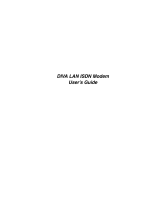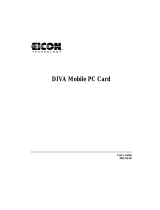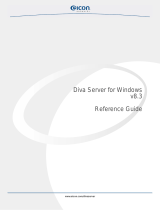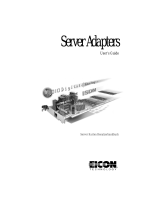Page is loading ...

Proprietary Extension for
COMMON-ISDN-API
Version 2.0
Extension for Fax Paper Formats
and Resolutions
October 2007
Dialogic Corporation

2
COPYRIGHT NOTICE AND LEGAL DISCLAIMER
Sixth Edition (October 2007) 206-412-06
Copyright © 1998-2007 Dialogic Corporation. You may not reproduce this document in whole or in part
without permission in writing from Dialogic Corporation at the address provided below.
All contents of this document are subject to change without notice and do not represent a commitment
on the part of Dialogic Corporation or its subsidiaries (“Dialogic”). Reasonable effort is made to ensure
the accuracy of the information contained in the document. However, due to ongoing product
improvements and revisions, Dialogic Corporation and its subsidiaries do not warrant the accuracy of
this information and cannot accept responsibility for errors or omissions that may be contained in this
document.
INFORMATION IN THIS DOCUMENT IS PROVIDED IN CONNECTION WITH DIALOGIC
®
PRODUCTS. NO LICENSE, EXPRESS OR IMPLIED, BY ESTOPPEL OR OTHERWISE, TO ANY
INTELLECTUAL PROPERTY RIGHTS IS GRANTED BY THIS DOCUMENT. EXCEPT AS
PROVIDED IN A SIGNED AGREEMENT BETWEEN YOU AND DIALOGIC, DIALOGIC ASSUMES
NO LIABILITY WHATSOEVER, AND DIALOGIC DISCLAIMS ANY EXPRESS OR IMPLIED
WARRANTY, RELATING TO SALE AND/OR USE OF DIALOGIC PRODUCTS INCLUDING
LIABILITY OR WARRANTIES RELATING TO FITNESS FOR A PARTICULAR PURPOSE,
MERCHANTABILITY, OR INFRINGEMENT OF ANY INTELLECTUAL PROPERTY RIGHT OF A
THIRD PARTY.
Dialogic products are not intended for use in medical, life saving, life sustaining, critical control or
safety systems, or in nuclear facility applications.
It is possible that the use or implementation of any one of the concepts, applications, or ideas
described in this document, in marketing collateral produced by or on web pages maintained by
Dialogic Corporation or its subsidiaries may infringe one or more patents or other intellectual property
rights owned by third parties. Dialogic Corporation or its subsidiaries do not provide any intellectual
property licenses with the sale of Dialogic products other than a license to use such product in
accordance with intellectual property owned or validly licensed by Dialogic Corporation or its
subsidiaries. More detailed information about such intellectual property is available from Dialogic
Corporation's legal department at 9800 Cavendish Blvd., 5th Floor, Montreal, Quebec, Canada H4M
2V9. The software referred to in this document is provided under a Software License Agreement.
Refer to the Software License Agreement for complete details governing the use of the software.
Dialogic Corporation encourages all users of its products to procure all necessary intellectual property
licenses required to implement any concepts or applications and does not condone or encourage any
intellectual property infringement and disclaims any responsibility related thereto. These intellectual
property licenses may differ from country to country and it is the responsibility of those who develop
the concepts or applications to be aware of and comply with different national license requirements.
Dialogic and Diva are registered trademarks of Dialogic Corporation or its subsidiaries (“Dialogic”).
Dialogic's trademarks may be used publicly only with permission from Dialogic. Such permission may
only be granted by Dialogic's legal department at 9800 Cavendish Blvd., 5th Floor, Montreal, Quebec,
Canada H4M 2V9. Any authorized use of Dialogic's trademarks will be subject to full respect of the
trademark guidelines published by Dialogic from time to time and any use of Dialogic's trademarks
requires proper acknowledgement.
The names of actual companies and products mentioned herein are the trademarks of their respective
owners.
To contact Dialogic Customer Support, visit our Web site at www.dialogic.com.

3
Motivation: The current COMMON-ISDN-API specification defines paper formats
ISO A4, ISO B4 and ISO A3 at standard resolution (R8 x 3.85) and high
resolution (R8 x 7.7). Support for B4 and A3 is even optional.
The following document proposes a COMMON-ISDN-API extension
that enables FAX document transmission and reception with paper
formats ISO A4, ISO B4 and ISO A3 and these resolutions as specified
in T.30:
• R8 x 3.85
• R8 x 7.7
• R8 x 15.4
• R16 x 15.4
• 200 x 200
• 300 x 300
• 400 x 400
The page format and resolution information is passed via appropriate
fields in the SFF page header.
To reduce the additions required in a CAPI application in order to make
use of the extension, the new functionality is added directly to the
existing SFF format. This means that there is a possibility of conflict
with future official extensions of the COMMON-ISDN-API. To prevent
incompatibilities, support for FAX paper formats and resolutions must be
enabled explicitly so as to turn off any future CAPI extension that would
cause incompatibility.
Specifically, it has to be enabled by the application for a designated
controller through a manufacturer request command 9 (Options request)
with bit 6 (Enable FAX paper formats and resolutions) set. It will stay
active until either the application releases the COMMON-ISDN-API or
issues another options request with bit 6 not set.
An application can determine whether the COMMON-ISDN-API
supports FAX paper formats and resolutions by examining the CAPI
profile and searching the manufacturer string for "Eicon" or by
examining the CAPI profile and trying the manufacturer command 9
described below.
Changes since the first version from 12.1.2001:
• Added support for resolutions 300 x 600, 400 x 800, 600 x 1200, 600
x 600 and 1200 x 1200 dpi.

4
4.2.2.7 CAPI_GET_PROFILE
Applications call CAPI_GET_PROFILE to retrieve capability information from COMMON-ISDN-API.
COMMON-ISDN-API copies information about implemented features, the total number of controllers, and
protocols supported by the requested controller to a 64-byte buffer passed by the calling application. The
application must ignore unknown bits. COMMON-ISDN-API sets reserved fields to zero.
CAPI_GET_PROFILE fills the buffer with the following structure:
Type Description
2 bytes number of installed controllers, least significant byte first
2 bytes number of supported B-channels, least significant byte first
4 bytes Global Options (bit field):
[0]: internal controller supported
[1]: external equipment supported
[2]: Handset supported (external equipment must also be set)
[3]: DTMF supported
[4]: Supplementary Services (see Part III)
[5]: channel allocation supported (leased lines)
[6]: parameter B channel operation supported
[7]: Line Interconnect supported
[8]...[31]: reserved
4 bytes B1 protocol support (bit field):
[0]: 64 kbit/s with HDLC framing, always set.
[1]: 64 kbit/s bit-transparent operation with byte framing
from the network
[2]: V.110 asynchronous operation with start/stop byte
framing
[3]: V.110 synchronous operation with HDLC framing
[4]: T.30 modem for fax group 3
[5]: 64 kbit/s inverted with HDLC framing.
[6]: 56 kbit/s bit-transparent operation with byte framing
from the network
[7]: Modem with all negotiations
[8]: Modem asynchronous operation with start/stop byte
framing
[9]: Modem synchronous operation with HDLC framing
[10]...[31]: reserved
4 bytes B2 protocol support (bit field):
[0]: ISO 7776 (X.75 SLP), always set
[1]: Transparent
[2]: SDLC
[3]: LAPD in accordance with Q.921 for D-channel X.25
(SAPI 16)
[4]: T.30 for fax group 3
[5]: Point-to-Point Protocol (PPP)
[6]: Transparent (ignoring framing errors of B1 protocol)
[7]: Modem error correction and compression (V.42 bis or
MNP5)
[8]: ISO 7776 (X.75 SLP) modified supporting V.42 bis
compression
[9]: V.120 asynchronous mode
[10]: V.120 asynchronous mode supporting V.42 bis
[11]: V.120 bit-transparent mode
[12]: LAPD in accordance with Q.921 including free SAPI
selection
[13]...[31]: reserved

5
4 bytes B3 protocol support (bit field):
[0]: Transparent, always set
[1]: T.90NL with compatibility to T.70NL in accordance to
T.90 Appendix II.
[2]: ISO 8208 (X.25 DTE-DTE)
[3]: X.25 DCE
[4]: T.30 for fax group 3
[5]: T.30 for fax group 3 with extensions
[6]: reserved
[7]: Modem
[8]...[31]: reserved
24 bytes reserved for COMMON-ISDN-API use
4 bytes Private options (bit field):
[0]...[5]: reserved
[6]: FAX paper formats and resolutions
[7]...[31]: reserved
16 bytes Manufacturer-specific information
CAPI_GET_PROFILE information structure

6
Manu ID (dword)
The purpose of the parameter Manu ID is to communicate a dword which identifies the
manufacturer in MANUFACTURER messages. Every manufacturer supplying MANU-
FACTURER messages should choose a unique value (such as an abbreviation of the company
name).
The manufacturer ID used by Dialogic is:
0x44444944
This information element appears in:
MANUFACTURER_REQ
MANUFACTURER_RESP
MANUFACTURER_CONF
MANUFACTURER_IND
Manufacturer Specific
The purpose of the parameter manufacturer specific is to exchange manufacturer-specific infor-
mation.
Manufacturer specific information for MANUFACTURER_REQ:
word manufacturer
command
Manufacturer specific operation requested.
struct manufacturer
command parameters
Command-dependent parameters for manufacturer request.
Manufacturer specific information for MANUFACTURER_CONF:
word manufacturer
command
Manufacturer-specific operation that was requested.
word info Result of the operation according to COMMON-ISDN-API
definition of Info.
This information element appears in:
MANUFACTURER_REQ
MANUFACTURER_RESP
MANUFACTURER_CONF
MANUFACTURER_IND

7
Manufacturer Command
The purpose of the parameter manufacturer command is to specify the kind of operation requested
in a MANUFACTURER_REQ.
The following manufacturer commands are defined:
1: Assign PLCI
2: Advanced Codec control
3: DSP control
4: Signaling control
5: RXT control
6: IDI control
7: Configuration control
8: Remove Codec
9: Options request
This information element appears in:
Manufacturer Specific
Manufacturer Command Parameters
The purpose of the parameter manufacturer command parameters is to specify command
dependent parameters.
Parameters for manufacturer command 9: Options Request:
dword Options mask Manufacturer specific options that have to be enabled:
[Bit 0..5]: reserved, must be set to 0
[Bit 6]: Enable FAX paper formats and resolutions
[Bit 7..31]: reserved, must be set to 0
This information element appears in:
Manufacturer Command

8
ANNEX B (NORMATIVE): SFF FORMAT
B.1 Introduction
SFF (Structured Fax File) is a representation specific to fax group 3 documents. As
shown below in Fiugre 6 it consists of information concerning the page structure and
compressed line data of the fax document. An SFF-formatted document always starts
with a header, which is valid for the complete document. Every page starts with a page
header. This is followed by the pixel information, line by line. As the SFF format is a
file format specification, some entries in header structures (e.g. double-chaining of
pages) may not be used or supported by COMMON-ISDN-API.
document
header
page 1
header
page 1
data
page 2
header
page 2
data
... page n
data
Figure 6: SFF format
B.2 SFF coding rules
The following type conventions are used:
byte 8-bit unsigned
word 16-bit unsigned integer, least significant octet first
dword 32-bit unsigned integer, least significant word first
B.2.1 Document header
Parameter Type Comment
SFF_Id dword Magic value (identification) of SFF Format: coded as
0x66666653 ("SFFF")
Version byte Version number of SFF document: coded 0x01
reserved byte Reserved for future extensions; coded 0x00
User Information word Manufacturer-specific user information (not used by COM-
MON-ISDN-API, coded as 0x0000)
Page Count word Number of pages in the document. Must be coded 0x0000 if
not known (as in the case of receiving a document).
OffsetFirstPageHeader word Byte offset of first page header from start of document
header. This value is normally equal to the size of the docu-
ment header (0x14), but there could be additional user-
specific data between the document header and the first page
header. COMMON-ISDN-API ignores and does not provide
such additional data.
OffsetLastPageHeader dword Byte offset of last page header from start of document header.
Must be coded 0x00000000 if not known (as in the case of
receiving a document).
OffsetDocumentEnd dword Byte offset of document end from start of document header.
Must be coded 0x00000000 if not known (as in the case of
receiving a document).

9
B.2.2 Page header
Parameter Type Comment
PageHeaderID byte 254 (Page data record type)
PageHeaderLen byte 0: Document end
1...255: byte offset of first page data from the Resolution
Vertical field of the page header. This value is normally equal
to the size of the remainder of the header (0x10), but there
could be additional user-specific data between page header
and page data. COMMON-ISDN-API ignores and does not
provide such additional data.
Resolution Vertical byte Definition of vertical resolution; different resolutions in one
document may be ignored by COMMON-ISDN-API
0: 98 lpi (standard)
1:: 196 lpi (high resolution)
2...254: reserved
255: end of document (should not be used: PageHeaderLen
should be coded 0 instead)
If FAX paper formats and resolutions are enabled
0x00: 98 lpi (3.85 lines per millimeter)
0x01: 196 lpi (7.7 lines per millimeter)
0x02..0x7f: reserved
0x80: reserved
0x81: 100 lpi
0x82: reserved
0x83: 200 lpi
0x84: reserved
0x85: 300 lpi
0x86: 392 lpi (15.4 lines per millimeter)
0x87: 400 lpi
0x88..0x8a: reserved
0x8b: 600 lpi
0x8c..0x8e: reserved
0x8f: 800 lpi
0x90..0x96: reserved
0x97: 1200 lpi
0x98..0xff: reserved
Resolution Horizontal byte Definition of horizontal resolution
0: 203 dpi (standard)
1...255: reserved
If FAX paper formats and resolutions is enabled
0x00: 203 dpi (R8, 8 pels per millimeter)
0x01..0x7f: reserved
0x80: reserved
0x81: reserved
0x82: reserved
0x83: 200 dpi
0x84: reserved
0x85: 300 dpi
0x86: 406 dpi (R16, 16 pels per millimeter)
0x87: 400 dpi
0x88..0x8a: reserved
0x8b: 600 dpi
0x8c..0x96: reserved
0x97: 1200 dpi
0x98..0xff: reserved
Coding byte Definition of pixel line coding
0: modified Huffman coding
1...255: reserved
reserved byte Coded as 0

10
Line Length word Number of pixels per line
1728: standard fax G3
2048: B4 (optional)
2432: A3 (optional)
Support for additional values is optional for COMMON-
ISDN-API
If FAX paper formats and resolutions are enabled
1728: ISO A4 at R8 x 3.85, R8 x 7.7, R8 x 15.4, 200 x 200
2048: ISO B4 at R8 x 3.85, R8 x 7.7, R8 x 15.4, 200 x 200
2432: ISO A3 at R8 x 3.85, R8 x 7.7, R8 x 15.4, 200 x 200
2592: ISO A4 at 300 x 300, 300 x 600
3072: ISO B4 at 300 x 300, 300 x 600
3648: ISO A3 at 300 x 300, 300 x 600
3456: ISO A4 at R16 x 15.4, 400 x 400, 400 x 800
4096: ISO B4 at R16 x 15.4, 400 x 400, 400 x 800
4864: ISO A3 at R16 x 15.4, 400 x 400, 400 x 800
5184: ISO A4 at 600 x 600, 600 x 1200
6144: ISO B4 at 600 x 600, 600 x 1200
7296: ISO A3 at 600 x 600, 600 x 1200
10368: ISO A4 at 1200 x 1200
12288: ISO B4 at 1200 x 1200
14592: ISO A3 at 1200 x 1200
Page Length word Number of pixel lines per page. If not known, coded as
0x0000.
OffsetPreviousPage dword Byte offset to previous page header or 0x00000000. Coded as
0x00000001 if first page.
OffsetNextPage dword Byte offset to next page header or 0x00000000. Coded as
0x00000001 if last page.
B.2.3 Page data
Page data are coded line by line: data describes each pixel row. Lines are coded as
records of variable length; each line is coded according to the element coding in the
page header. At present, only modified Huffman coding is supported. MH coding is
bit-oriented: the pixel bits are stored in the bits of code words least significant first. No
EOL code words or fill bits are included. If the data include EOL code words,
COMMON-ISDN-API ignores these.
Each record is identified by the first byte:
• 1...216: a pixel row with 1...216 MH-coded bytes follows immediately
• 0: escape code for a pixel row with more than 216 MH-coded bytes. In this case, the following
word in the range 218...32767 defines the number of MH-coded bytes which follow.
• 217...253: white space, skip 1...37 empty lines
• 254: start of page header (see above)
• 255: if followed by a byte with value 0, illegal line coding. Applications may choose whether
to interpret this line as empty or as a copy of the previous line. If this byte is followed by a byte
with a value 1...255, then 1...255 bytes of additional user information follow (reserved for
future extensions).
/





